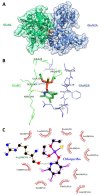Chlorpyrifos Acts as a Positive Modulator and an Agonist of N-Methyl-d-Aspartate (NMDA) Receptors: A Novel Mechanism of Chlorpyrifos-Induced Neurotoxicity
- PMID: 39846544
- PMCID: PMC11755529
- DOI: 10.3390/jox15010012
Chlorpyrifos Acts as a Positive Modulator and an Agonist of N-Methyl-d-Aspartate (NMDA) Receptors: A Novel Mechanism of Chlorpyrifos-Induced Neurotoxicity
Abstract
Chlorpyrifos (CPF) is a broad-spectrum organophosphate insecticide. Long-term exposure to low levels of CPF is associated with neurodevelopmental and neurodegenerative disorders. The mechanisms leading to these effects are still not fully understood. Normal NMDA receptor (NMDAR) function is essential for neuronal development and higher brain functionality, while its inappropriate stimulation results in neurological deficits. Thus, the current study aimed to investigate the role of NMDARs in CPF-induced neurotoxicity. We show that NMDARs mediate CPF-induced excitotoxicity in differentiated human fetal cortical neuronal ReNcell CX stem cells. In addition, by using two-electrode voltage clamp electrophysiology of Xenopus oocytes expressing NMDARs, we show CPF potentiation of both GluN1-1a/GluN2A (EC50 ≈ 40 nM) and GluN1-1a/GluN2B (EC50 ≈ 55 nM) receptors, as well as reductions (approximately halved) in the NMDA EC50s and direct activation by 10 μM CPF of both receptor types. In silico molecular docking validated CPF's association with NMDARs through relatively high affinity binding (-8.82 kcal/mol) to a modulator site at the GluN1-GluN2A interface of the ligand-binding domains.
Keywords: NMDA receptors; Xenopus oocytes; chlorpyrifos; neurotoxicity; organophosphate; stem cells; two-electrode voltage clamp.
Conflict of interest statement
The authors declare no conflicts of interest.
Figures






Similar articles
-
GluN2A Subunit-Containing NMDA Receptors Are the Preferential Neuronal Targets of Homocysteine.Front Cell Neurosci. 2016 Nov 1;10:246. doi: 10.3389/fncel.2016.00246. eCollection 2016. Front Cell Neurosci. 2016. PMID: 27847466 Free PMC article.
-
Structural basis of subunit selectivity for competitive NMDA receptor antagonists with preference for GluN2A over GluN2B subunits.Proc Natl Acad Sci U S A. 2017 Aug 15;114(33):E6942-E6951. doi: 10.1073/pnas.1707752114. Epub 2017 Jul 31. Proc Natl Acad Sci U S A. 2017. PMID: 28760974 Free PMC article.
-
Mapping the high-affinity binding domain of 5-substituted benzimidazoles to the proximal N-terminus of the GluN2B subunit of the NMDA receptor.Br J Pharmacol. 2010 Jan 1;159(2):449-61. doi: 10.1111/j.1476-5381.2009.00549.x. Epub 2010 Jan 15. Br J Pharmacol. 2010. PMID: 20082612 Free PMC article.
-
GluN2A and GluN2B N-Methyl-D-Aspartate Receptor (NMDARs) Subunits: Their Roles and Therapeutic Antagonists in Neurological Diseases.Pharmaceuticals (Basel). 2023 Oct 30;16(11):1535. doi: 10.3390/ph16111535. Pharmaceuticals (Basel). 2023. PMID: 38004401 Free PMC article. Review.
-
Long-term potentiation and the role of N-methyl-D-aspartate receptors.Brain Res. 2015 Sep 24;1621:5-16. doi: 10.1016/j.brainres.2015.01.016. Epub 2015 Jan 22. Brain Res. 2015. PMID: 25619552 Free PMC article. Review.
References
-
- Saunders M., Magnanti B.L., Carreira S.C., Yang A.L., Alamo-Hernández U., Riojas-Rodriguez H., Calamandrei G., Koppe J.G., von Krauss M.K., Keune H., et al. Chlorpyrifos and neurodevelopmental effects: A literature review and expert elicitation on research and policy. Environ. Health-Glob. 2012;11:S5. doi: 10.1186/1476-069X-11-S1-S5. - DOI - PMC - PubMed
-
- CRD Chemical Regulation Directorate: Plant Protection Products Regulation (EC) No 1107/2009 of March 2016 Concerning Withdrawal of Plant Protection Products in the United Kingdom. [(accessed on 14 June 2024)];2016 Available online: https://secure.pesticides.gov.uk/pestreg/getfile.asp?documentid=29755&ap....
LinkOut - more resources
Full Text Sources

